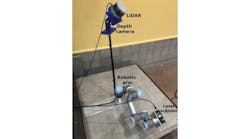The Atlantic salmon farming business artificially controls smoltification, the process during which juvenile freshwater salmon undergo physiological changes and adapt to seawater. Lights and special feed trigger and control the process to maintain the smooth production of new fish for sea farms. Verifying smoltification process completion prevents the fish from dying when moved from a fresh water to a saltwater environment.
Traditional measures include sampling chloride content in blood samples after exposing the fish to saline water or analyzing tissue samples from gills for the presence of ion-transporting enzymes. Observing the color, texture, and light reflectivity of skin also may determine whether smoltification has occurred or not. The results of these time-consuming tests conducted on individual fish from populations of hundreds of thousands that require evaluation by experts may not represent the entire group.
A hyperspectral imaging system developed by researchers as described in the paper, “Identification of spectral signature for in situ real-time monitoring of smoltification” (bit.ly/VSD-SMLT), uses color and reflectivity to identify salmon as either being in the juvenile or the mature phase. This new system is fast, doesn’t rely on observation by experts, and eliminates the possibility of injuring juvenile fish that cannot handle salt water during tests.
The experimental system consists of an FX10 hyperspectral camera from SPECIM (Oulum, Finland; www.specim.com) equipped with a 23 mm/f.2.4. lens, mounted on a SPECIM LabScanner tray. The first phase of the experiment used standard halogen lights from SPECIM. Subsequent phases used the Lumia 5.2 LED array from CREE (Racine, WI, USA; www.creelighting.com) because of concern for heat generated by the halogen lights.
The application ran on an SH110G PC from Shuttle (Taipei, Taiwan; www.global1.shuttle.com)with an i7 processor from Intel (Santa Clara, CA, USA; www.intel.com), 16 GB D4 2400 memory, solid-state SATA HD drive, and Karbon CL2 frame grabber from BitFlow (Woburn, MA, USA; www.bitflow.com).
The researchers compared hyperspectral data to the results of tests on blood and gill tissue samples, taken from random samplings of fish from the same tank. A total of 314 fish from three different production sites were tested.
Hyperspectral data analysis took place in four steps. First, the researchers labeled the data for each salmon as “parr” (juvenile) or “smolt” (mature) based on the results of the traditional analysis. Next, a black and white image calibration removed variations from lighting differences. This ensured that skin reflectance measurement results were accurate.
In step three, the hyperspectral data were analyzed on a wavelength range of 400 nm (the camera’s lowest sensing limit) to 700 nm, avoiding higher wavelengths that may have been altered by the instability of the halogen lights in the first phase of the testing. Finally, a machine learning classifier searched each image for spectral characteristics that designated a fish as either parr or smolt.
The optimal wavelengths by which the classifier could successfully differentiate parr and smolt changed depending on the testing site. The researchers attributed this to differences in average water temperature, dissolved oxygen, water opacity and color, lighting, and feeding regimes. The classifier’s accuracy at identifying fish as parr or smolt recorded at 90% overall.






